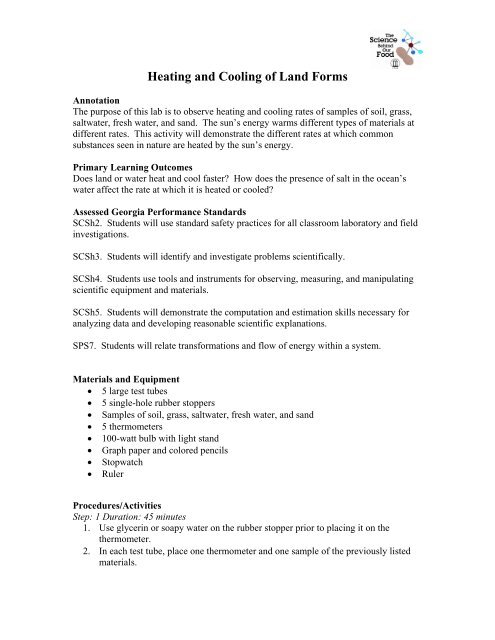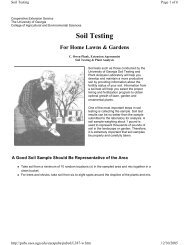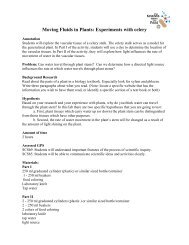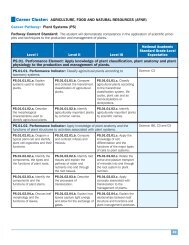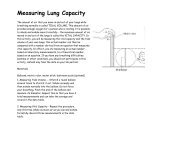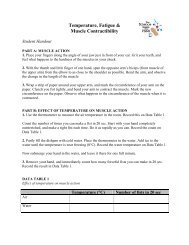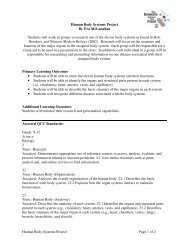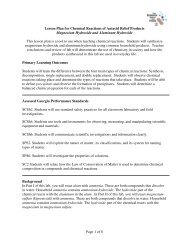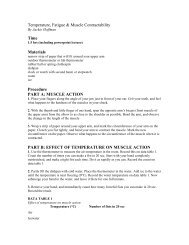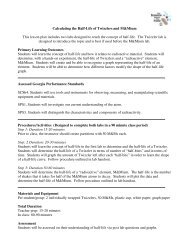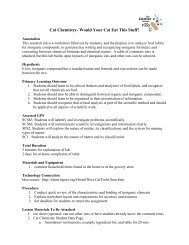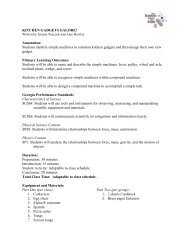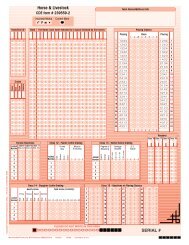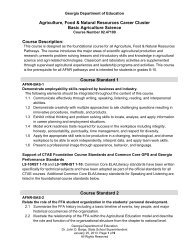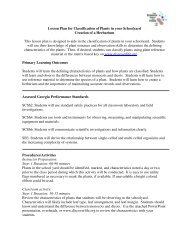Heating and Cooling of Land Forms.pdf
Heating and Cooling of Land Forms.pdf
Heating and Cooling of Land Forms.pdf
You also want an ePaper? Increase the reach of your titles
YUMPU automatically turns print PDFs into web optimized ePapers that Google loves.
<strong>Heating</strong> <strong>and</strong> <strong>Cooling</strong> <strong>of</strong> L<strong>and</strong> <strong>Forms</strong><br />
Annotation<br />
The purpose <strong>of</strong> this lab is to observe heating <strong>and</strong> cooling rates <strong>of</strong> samples <strong>of</strong> soil, grass,<br />
saltwater, fresh water, <strong>and</strong> s<strong>and</strong>. The sun’s energy warms different types <strong>of</strong> materials at<br />
different rates. This activity will demonstrate the different rates at which common<br />
substances seen in nature are heated by the sun’s energy.<br />
Primary Learning Outcomes<br />
Does l<strong>and</strong> or water heat <strong>and</strong> cool faster How does the presence <strong>of</strong> salt in the ocean’s<br />
water affect the rate at which it is heated or cooled<br />
Assessed Georgia Performance St<strong>and</strong>ards<br />
SCSh2. Students will use st<strong>and</strong>ard safety practices for all classroom laboratory <strong>and</strong> field<br />
investigations.<br />
SCSh3. Students will identify <strong>and</strong> investigate problems scientifically.<br />
SCSh4. Students use tools <strong>and</strong> instruments for observing, measuring, <strong>and</strong> manipulating<br />
scientific equipment <strong>and</strong> materials.<br />
SCSh5. Students will demonstrate the computation <strong>and</strong> estimation skills necessary for<br />
analyzing data <strong>and</strong> developing reasonable scientific explanations.<br />
SPS7. Students will relate transformations <strong>and</strong> flow <strong>of</strong> energy within a system.<br />
Materials <strong>and</strong> Equipment<br />
• 5 large test tubes<br />
• 5 single-hole rubber stoppers<br />
• Samples <strong>of</strong> soil, grass, saltwater, fresh water, <strong>and</strong> s<strong>and</strong><br />
• 5 thermometers<br />
• 100-watt bulb with light st<strong>and</strong><br />
• Graph paper <strong>and</strong> colored pencils<br />
• Stopwatch<br />
• Ruler<br />
Procedures/Activities<br />
Step: 1 Duration: 45 minutes<br />
1. Use glycerin or soapy water on the rubber stopper prior to placing it on the<br />
thermometer.<br />
2. In each test tube, place one thermometer <strong>and</strong> one sample <strong>of</strong> the previously listed<br />
materials.
3. Place all five test tubes in clamps <strong>and</strong> secure the tubes/clamps under the lamp.<br />
4. Record the beginning temperature <strong>of</strong> each material.<br />
5. Turn on the lamp.<br />
6. Record the heating temperature at each minute.<br />
7. At minute 15, record the temperatures then turn <strong>of</strong>f the lamp.<br />
8. Record the cooling temperatures every minute until minute 30.<br />
9. Graph recorded results on a graph paper using appropriate scale. (Suggestion:<br />
You might want to use a different colored pencil for each material.)<br />
Step 2: Duration 30 minutes<br />
Students should answer the following questions:<br />
1. Which material heated up the fastest <strong>and</strong> slowest Why<br />
2. Which material cooled <strong>of</strong>f the fastest <strong>and</strong> slowest Why<br />
3. Were there any differences in the heating <strong>and</strong> cooling <strong>of</strong> the salt <strong>and</strong> fresh water<br />
If so, what were the differences <strong>and</strong> why do you think they exist<br />
4. At the beach on a sunny day, the s<strong>and</strong> is much hotter than the water. Why is this<br />
Total Duration<br />
1 hour 15 minutes<br />
Assessment<br />
Students can be assessed through participation in laboratory activity, as well as through<br />
the grading <strong>of</strong> the laboratory questions.
Laboratory Worksheet<br />
Time<br />
1:00<br />
2:00<br />
3:00<br />
4:00<br />
5:00<br />
6:00<br />
7:00<br />
8:00<br />
9:00<br />
10:00<br />
11:00<br />
12:00<br />
13:00<br />
14:00<br />
15:00<br />
16:00<br />
17:00<br />
18:00<br />
19:00<br />
20:00<br />
21:00<br />
22:00<br />
23:00<br />
24:00<br />
25:00<br />
26:00<br />
27:00<br />
28:00<br />
29:00<br />
30:00<br />
Soil S<strong>and</strong> Grass Saltwater<br />
Fresh<br />
Water<br />
<strong>Heating</strong><br />
Time<br />
<strong>Cooling</strong><br />
Time


